Chat, Text, Call, Post: A Local Business’s Guide to Success on Any Channel

Whether it’s across phone, email, video, or text, there’s no question: It’s never been easier to stay connected. But with options comes complexity—especially for small and local businesses that must juggle communication across multiple channels while maintaining a great customer experience.
And the truth is, for most small businesses, balancing the complexity of modern communications and still delivering a great customer experience is a struggle.
No one wants to feel like they’re talking to a robot. Yes, almost 40% of small businesses admit it’s challenging to connect with customers on their preferred channels, respond to inquiries quickly, and provide a consistent experience.
So, how can your business communicate more successfully with customers in a multi-channel world—without losing the human touch?
You need a communication strategy that scales across phone, email, web, text, and more. This guide will teach you how to:
- Use modern technology to connect with customers and scale your business (without breaking the bank)
- Use best practices to drive a consistent experience across your different channels
- Set response times and measure other success factors such as conversion rates, open rates, and more
Get Talking: Communicating with Modern Customers
Ease of doing business is the most important aspect of any customer experience.
In fact, 54% of people say it’s the top reason they choose a local company.
Of course, a key component of “ease of business” is being able to communicate quickly and conveniently with a business. But this has gotten harder to do as communication technologies have increased. In the past, customers were at the whims of businesses when it comes to how they can reach out. Over time, however, that narrative has been flipped on its head.

The Evolution of Customer Communication
Not so long ago, most communication for small and local businesses happened by phone or in person. But times have changed. Email, web forms, social media, chat, and text are all common ways modern customers want to communicate with businesses.
In addition, marketing and advertising your local business was usually done on channels like TV, radio, billboards, bus benches, and direct mail. While these channels haven’t disappeared, digital channels have grown in popularity.
Today, 97% of people learn about local companies online more than anywhere else.
46% of all Google searches are looking for local information, and 78% of location-based mobile searches result in an offline purchase.
With customers consistently using multiple digital channels, all businesses—especially small and local businesses—must be online and across channels to succeed in today’s modern world of customer communications.

What Communication Channels Should You Focus On Today?
Knowing that your business needs to support multiple channels can be intimidating and potentially costly. The good news is that you don’t need to be on every available channel, but you do need to be on the channels your customers use most frequently.
 Here are the essential channels your businesses should consider as part of your overall communication strategy:
Here are the essential channels your businesses should consider as part of your overall communication strategy:
Text
The vast majority (90%) of consumers prefer to engage with a business through texting or another messaging app. Moreover, 67% of consumers think texting with businesses would increase convenience. Yet, two-thirds of consumers say less than one-third of small businesses use text to communicate.
Online Chat
Adding chat to your website can be a worthwhile investment, especially when you use a web chat technology that lets employees respond to chat messages and allows you to switch between chat and text effortlessly. Almost 72% of customers say they are more likely to purchase from a business site that communicates with them about their products in real-time with a real employee via chat.
Email is an essential communication tool in today’s world. It is one of the most widely used digital tools for communication and marketing. It’s also a great channel to build long-term relationships with customers or potential customers.
Phone
While text has gained greater popularity, the phone remains an important channel—and it’s still best if you can answer calls immediately with a live person. Two-thirds of customers report that it takes too long to reach a live person. And most won’t wait around. Over one-third of customers on hold will hang up within one minute.
As you evaluate whether all these channels are right for your business, consider the following:
- Which channels are you using that are already working successfully?
- Which new channels would make sense for your customers?
- What business use cases would these channels support?
- How does each channel fit together to ensure you’re providing the best overall experience possible?
At American 1 Credit Union, they’ve given these questions a lot of thought. With a small budget and team, it’s been essential to select channels that will have the most impact and master those versus branching out to every channel.

“We’ve found success in doing a limited number of channels really well,” says Marla Sanford, VP of Marketing and Communications at American 1 Credit Union. “We don’t use Twitter, but we do that strategically because we know that if we were to add another channel like Twitter, we’d need somebody dedicated to the Twitter space to do it well.”
“Each channel has its own unique characteristics, so you have to have a really good benchmark to know whether or not that channel is performing better than or worse than the standard benchmark that you set.” –Robert Wilgus, Marketing Director for Rentokil/ Environmental Pest
And knowing your audience matters too. Lauren Donahoo, the Marketing Director at Professional Physical Therapy notes how a 97-year-old interacts with their brand is very different from how a 17-year-old does. As a result, what channels your customers want to use will be very different.
Embracing Marketing & Sales Automation
There is a significant opportunity to use communication channels to market to customers and close sales. You can use marketing and sales automation on channels like text, chat, and email more cost-effectively than other marketing and sales channels while also seeing more powerful results.
SMS (or text) is one of the most cost-effective marketing campaigns you can run as a local business. The average cost-per-click with Podium is $0.10 versus $1-$2 with Google Ads. Consumers also redeem SMS-delivered coupons 10 times more than other types of coupons.
Text can also help your business close more sales and get paid faster. In a review of the average rate of collection across mobile payment customers, the average collection rate for text-based billing is 42% upon delivery of the first text message.
In fact, it may cost your business more not to invest in modern communication tools like text, online chat, and email marketing automation.
At Griffin Fast Lube, customer communication was a real struggle. Consequently, the company saw a decline in repeat business, which was 70% of their base customers. Once they implemented a text solution, which allowed them to follow up more efficiently with customers, the company saw a 7% increase in repeat customers.

Vineyard, a fast-growing city in northern Utah County, has similarly found that its investment in chat has paid off. Vineyard uses Podium Webchat to field more questions from residents in less time, as well as using Podium Payments to process payments for permits, business licensing, tickets to community events, and vendor payments. It uses texting through Podium to organize community events and communicate with vendors.
The investment has had a critical impact on how they manage communications. The city has saved 10+ employee hours per week, achieved a less than 20-minute response time for all messages, and has had over 1,700 conversations in the last 12 months with citizens via text or online chat. In addition, accepting payment by text has resulted in an average time to payment of fewer than 12 hours.
Vineyard, a fast-growing city in northern Utah County, has similarly found that its investment in chat has paid off. Vineyard uses Podium Webchat to field more questions from residents in less time, as well as using Podium Payments to process payments for permits, business licensing, tickets to community events, and vendor payments. It uses texting through Podium to organize community events and communicate with vendors.
The investment has had a critical impact on how they manage communications. The city has saved 10+ employee hours per week, achieved a less than 20-minute response time for all messages, and has had over 1,700 conversations in the last 12 months with citizens via text or online chat. In addition, accepting payment by text has resulted in an average time to payment of fewer than 12 hours.

Now that we’ve shared examples of how businesses are using multi-channel communication to connect with their customers, let’s look at how you can better use these channels today.

Phone Calls Aren’t Dead: Make Your Call Strategy Seamless
Talking on the phone might feel antiquated to some, but almost 61% of U.S. adults still prefer calling support teams when they have an issue to resolve. Plus, many older adults still lag in adopting digital communication channels.
The tricky part about phone calls is that they can be interruptive and demand immediate attention. They can also be time-consuming. A modern call strategy can help reduce your staff’s time on the phone while making it a better experience for your customers.
Setting Expectations with Your Team
The first part of your call strategy should be setting expectations around phone calls:
- Who is responsible for answering the phone?
- How will you route calls to the right person?
- How will you handle missed calls or multiple calls at once?
- When calls are missed, how do you make sure they get followed up on?
- How do you keep track of customer calls that might require additional follow-up?
If you take the time to outline what processes you’ll follow to manage calls, you’ll be less likely to miss calls, make customers wait on hold, or require customers to repeat themselves multiple times to multiple people.
One of the best ways to reduce time on the phone is to train your employees thoroughly. The greater your staff’s experience and skill, the faster and better they can solve customer problems and answer customer inquiries. And, when employees are well-trained and have clear expectations about their role in managing phone calls, your customer communications will go much smoother.
Managing Call Volume and Deflection Tactics
When your phone is ringing off the hook, that’s usually a good sign—as long as you can manage the volume of calls. But if you miss too many or don’t quickly follow up with missed calls, you’re going to miss out on potential customers and sales.
To better manage call volume, there are a couple of key strategies your business can use:
- Use call deflection tactics. Call deflection is the strategy of transferring customers to a different channel to help them find a resolution quicker while reducing the time your staff has to spend on the phone. Interactive Voice Response (IVR), chatbots, or text can be great tools for call deflection follow-up.
- Offer alternative channels. Offer alternative service channels, like Webchat, text, or email, on your website and other marketing communications that can serve them faster and more efficiently.
- Integrate with your CRM to create a single database. One factor that significantly increases time on the phone is repetition. When your customers call multiple times and have to repeat who they are, what their pain points are, and who they spoke to last, you lose precious minutes that could be used to resolve their issues.
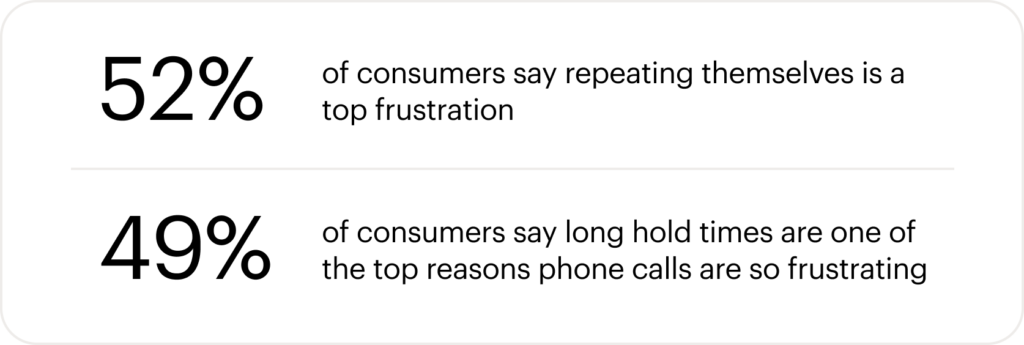
When reducing call time, you want to maintain a customer-centric mindset. It’s not about getting rid of customer calls and inquiries–it’s about vetting them, getting to them more quickly, and handling questions more deftly. The point isn’t just about just making you efficient, but helping more customers more efficiently. Reducing call time effectively centers around improving the customer experience while saving your business time and money.
Automating Phone Calls to Scale Communication
Phone automation addresses customer service needs in real-time and conserves business resources. And the benefits are clear: 76% of businesses that implement marketing automation generate positive ROI in just one year.
One simplified way to automate phone calls is through texting. For example:
- Prompt to text: Before the phone even rings at the business, the customer hears an automated message saying “If you’d like this business to text you instead of speaking over the phone, press two and we’ll send this phone number a text right away.” For customers on the go, this can be a better option.
- Automated texts off missed calls: If the business misses a call, they can set up an automation to text the caller’s number with a message, like “Hey it’s [NAME] from [BUSINESS]. I’m sorry we missed your call, what can I help you with today?” Keeps customers from immediately calling a competitor and makes them feel heard.
For Valley Roofing, which was experiencing incredible growth, it became clear that the current systems and processes needed to change to scale. “Our phone was ringing off the hook. Most new leads would call in, but even web form leads would need a sales rep to call them and set up an appointment,” said Joe Showalter, Sales Manager for Valley Roofing.
The back and forth on the phone to schedule an appointment took up a significant amount of time for the sales team and tied up the phone lines for the front desk as they fielded new inquiries. Texting capabilities, and the ability to convert phone calls to text messages, has saved the team time and improved the speed of conversations.

Text isn’t the only option available for automation. As previously mentioned, IVR can also be used to automate many customer inquiries, including:
- Account identification
- Transactional information
- Product assistance
- Sales call routing
- Appointment confirmations
In addition to reducing customer wait times, which improves the overall experience, using automation can also be cost-effective:
According to McKinsey, businesses that use technology, like automation, to revamp their customer experience can save up to 40% on service costs.

Business Phone Best Practices
The key to making all your customer communications run smoothly, including phone calls, is to use a combination of phone, text, and email in a modernized way.
A few best practices that can help you do this better include:
- Make your team ready for anything. Ensure your team takes notes on calls so future hires know what types of calls typically come in. Or, encourage them to adopt a “cheat sheet” for frequent call issues. Building processes is an important part of improving future call experiences.
- Focus on issue resolution. While you want to minimize your time on a phone with a customer, your primary goal should be to solve their issue. Work as efficiently and effectively as you can to do this, but remember it is better to take longer if needed to ensure you’ve resolved the issue to the customer’s satisfaction.
- Use other communication channels. Using text, chat, and even email can help you reduce customer wait times while still being able to deliver personalized service.

Just Text Me: The Power of Text Messaging
Could it have been a text?
For many buyers, texting is a more convenient, on-the-go option for communicating with companies. Consumers are twice as likely (1.8x) to prefer texting to any other communication method.
Not convinced text is a worthwhile investment? Consider the data:
- Text messaging has an open rate of up to 98%; on average, 95% of messages are opened within 3 minutes.
- Text messaging has a 209% higher response rate than phone, email, or Facebook.
- 40.5% of consumers say they are likely to switch to a different business because they offer text messaging to communicate.
- Consumers are twice as likely (1.8x) to prefer texting to any other communication method.
Even if you don’t need more convincing, you may still have many questions about how to implement text effectively and affordably in your business – and that’s what this section is all about!
What is SMS?
SMS stands for Short Message Service (SMS) and was first a means of sending messages of up to 160 characters to and from mobile handsets.
Today, texting and SMS are interchangeable terms and can be used to describe sending messages to and from mobile phones in a text format (though the technology has evolved to also support voice, images, and video).
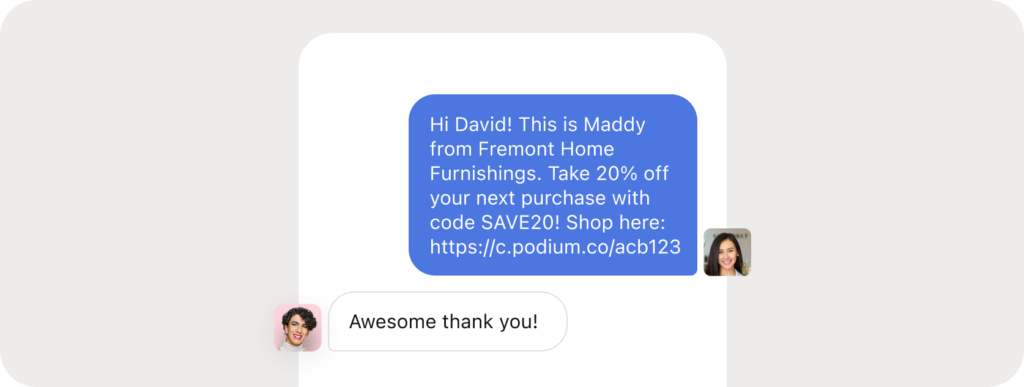
How to Use Texting Across Your Customer Journey
Texting can be used at every step of your customer journey—from the moment they first reach out to you online to building a long-term customer relationship that drives repeat business. But to realize the power of texting for your business, you first need to get people to opt-in to receive texts.
A successful text opt-in strategy should integrate opt-in entry points at every possible step of the customer journey, including:
Website Touchpoints
- Online sign-up pages and forms: Include a checkbox on any of these forms where you’re already collecting phone numbers to ask if they’d like to opt-in to text.
- Website banners, pop-ups, and prompts: Adding an incentive like receiving a coupon for opting in can incentivize more people.
- Website chat: When customers start a chat, you can set it up to go directly to text.
- Point of sale or transaction: While you can’t ask customers to purchase a product or service as a condition of consent, you can ask them voluntarily if they want to opt-in to text during the transaction.
- Reviews: When asking customers if they’d be willing to leave a review, you can ask if they want to opt-in to complete reviews via text.
Want More Reviews? Try Text.
You’ll likely see a significant increase in reviews when you use text. For example, Jackson Hewitt, a tax prep business, saw a 64% increase in the quantity of reviews year-over-year, increased their overall average star rating from 4.73 to 4.77, and saved certain franchise owners a combined 150 hours each tax season in reporting. Learn more 👉
Add a text opt-in option to every email you send—and give them a good reason why they would want to opt-in (promotions, notifications, event invites, etc.).
Social Media
Use promotions like “opt-in to get 20% off” on social media to encourage your followers to opt-in.
Mailers
Send direct mailers with QR codes, an easy-to-remember URL, or text-to-join-keyword to opt-in.
Physical Stores
You can have sign-up/opt-in stations in your stores or posters with QR codes or an URL strategically placed at your business to encourage customers to opt-in.
Tip: Consumers most want text messages with incentives, loyalty offers, and updates on inventory. So, when you’re encouraging customers to opt-in, make sure in your messaging that it’s clear that these are the types of communications they can expect.

Once you’ve gotten customers to opt-in, you can use text throughout the customer journey—from helping them with customer service questions and booking appointments to paying for services, collecting reviews, and offering promotions to encourage repeat business and greater loyalty.
Automating Texting to Scale Communication
Another valuable benefit of text is that you can easily scale communication in a more personalized manner than many other channels. For example, with the implementation of text messaging, customer service agents can often handle up to 8 conversations simultaneously.
It can also be more cost-effective to scale with text than by phone. Forrester reports that the average cost of a phone conversation at about $15.50 per interaction vs. $1 – $5 for 2-way text messaging.
Text is a Slam Dunk for the Utah Jazz
The Utah Jazz used to have a long sales cycle of lost emails and phone tag. They now provide an experience that’s more efficient, convenient, and engaging for both clients and sales reps. With Podium, the Utah Jazz team has seen incredible results. An estimated 70% of their sales now involve some level of texting, they’ve seen record-breaking revenue in a single game night using a textable number, and they’ve reduced their sales team’s response times to under five minutes. And, with a single inbox for all incoming messages and comprehensive reporting, the team has complete visibility into their most valuable asset–the customer experience. Learn more 👉
Business Texting Best Practices
Before you start texting away with customers, it’s important to know and follow best practices to ensure you’re in compliance—and to consistently provide a good experience that will lead to more conversions.
Maintain Compliance
The United States carefully regulates electronic communications. In addition to strict SMS federal rules, businesses must also observe all text messaging laws that apply to their region or state. Getting written explicit consent to text customers is the most critical aspect of business compliance.
Despite the importance of getting permission to text customers, 59% of consumers say they’ve been texted by a business to which they did not give permission. Some businesses may think these underhanded tactics may work, but 61% of consumers say they would unsubscribe from promotional messages from a local business if they received messages they didn’t recall signing up for.
Provide a Consistent and Personalized Experience
Over 60% of consumers want to hear from a business at least weekly. But, emailing more frequently can lead to unsubscribes. At the same time, if you want to convert more subscribers to customers, you need to make sure the experience meets their expectations and is relevant to them.
Here are a few best practices to keep in mind:
- Keep it short. Keep text messages to 160 characters or less.
- Introduce yourself. People want to know who they’re speaking with. 50% of consumers say they are more likely to respond to a text message from a business if they introduce themselves.
- Make it feel personal. 74% of consumers say they would be more likely to text with a local business if they knew a real person would receive and respond to their message.
- Increase engagement with multimedia texts. Over half of consumers are more likely to engage with multimedia messages. Make your messages interactive with links, gifs, and pics (even emojis!) to increase engagement.

Chatting Online: Connecting with Customers Across Your Website
Your website is one of the key places consumers will go to learn more about your business. However, they may not get all their questions answered and still need an easy way to communicate with you directly from your website. Chat is the perfect tool for this use case.
In fact, website chat is such a convenient and common communication feature that approximately 41% of customers expect to see it when they land on your website.

What is Online Chat & Why Use It?
Online chat is a dynamic communication tool businesses use to promote sales and offer real-time information on their website. You can use chat to answer product questions, provide customer service, or respond to technical issues.
Just how important is chat to your business and your customer’s experience? Consider these facts:
- 79% of businesses that started using webchat saw boosts in customer loyalty, revenue, and sales.
- 63% of customers are more likely to revisit a website with chat.
- The average order value increases by 10% for customers interacting with webchat before buying.
63% of customers are more likely to revisit a website with chat.
Many small and local businesses are finding that investing in chat has led to a very strong return on investment. The largest mattress retailer in the United States found that after adding a web chat platform at the beginning of the COVID-19 pandemic, web conversions increased by 24%, with sales totaling $14 million from April to August 2020.

Different Types of Chat Technology
There are two types of chat you can use: live chat or chatbots. Live chat provides interaction with a real human to support the conversation. Chatbots provide automated responses to commonly asked questions.
While chatbots can be useful for frequently asked questions, they are limited when it comes to more complex inquiries. So, if you do use chatbots, it’s still a good idea to have some way to transition customers to a live chat when human intervention or empathy is needed.
Live chat is also the leading method of digital contact for online communication. Nearly half of consumers say they prefer live chat. By comparison, 29% prefer email and 16% prefer social media.

In addition to chatbots and live chat, some chat technologies offer the ability to add a text-based Webchat tool. The advantage is that you can use it to engage customers on your website, but it also doesn’t force them to stay on the web page as chatbots do. Instead, they can convert the conversation to a text and keep engaging with you on the go.
Tip: Use a chat tool that makes it super easy for customers to initiate engagement. For example, Gold Coast Plumbing, which recently implemented Podium Webchat, has seen a 20% increase in leads because it’s easy for customers to enter their name, phone, and a brief message about what they need.
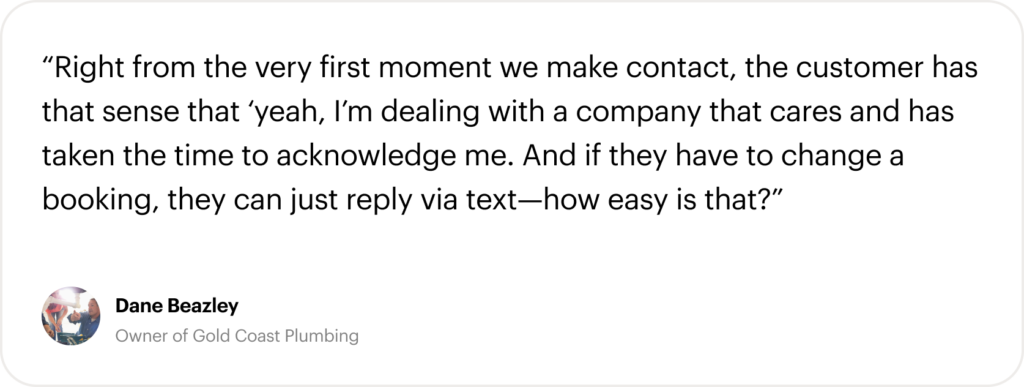
Automating Chat to Scale Communication
If you’re like many businesses, it’s not just about keeping track of all of your customer communications; a big part of the struggle is simply having the employee resources to keep up with responding to customer inquiries.
In addition, you also want to build strong relationships with your customers, which requires surveying them for feedback, asking for reviews, and sending out ongoing communication and promotions to keep your business top of mind.
One of the great things about website chat is that you can automate and streamline many marketing and communication tasks, including:
- Gather leads and contact information. When Webchat messages are submitted, you’ll instantly have their contact information for lead follow-up.
- Survey customers for feedback. Send out a link to a short survey they can complete when and where it’s convenient to do so.
- Solicit customer reviews. Provide a quick way for customers to rate and review your business.
- Collect payment. Make it easy for customers to pay on the go.
These different ways to automate communications add up to big savings in employee time. But most importantly, they generate better results than more manual and less automated processes like emailing, calling, or in-person interactions.
For instance, the quantity of reviews that Mattress Firm is collecting more than doubles the numbers they were getting (and are still getting!) from their email review request efforts—and they saw those results as quickly as the first three months.
Business Website Chat Best Practices
Consumers love chat because it offers a way to interact in real-time with a business—but only when chat is done well. And the two biggest factors in making chat a positive experience for your customers are speed of response and a personalized experience.
Here are a few tips to help you ensure that you deliver on both of those expectations:
- Use a picture of a person instead of a bot on your live chat feature. This way, people know they’re going to get human interaction.
- Customize your message so that it sounds like your brand. Use conversational language and emojis, and allow more complex responses than letters and numbers. This way, the employee or customer service agent responding can put some personality into their responses and make the conversation more fun and engaging.
- Be transparent. When your system reaches a point in the conversation that calls for a live employee, set up a triggered message such as “a live employee will text you shortly” so that the customer knows she is changing hands.
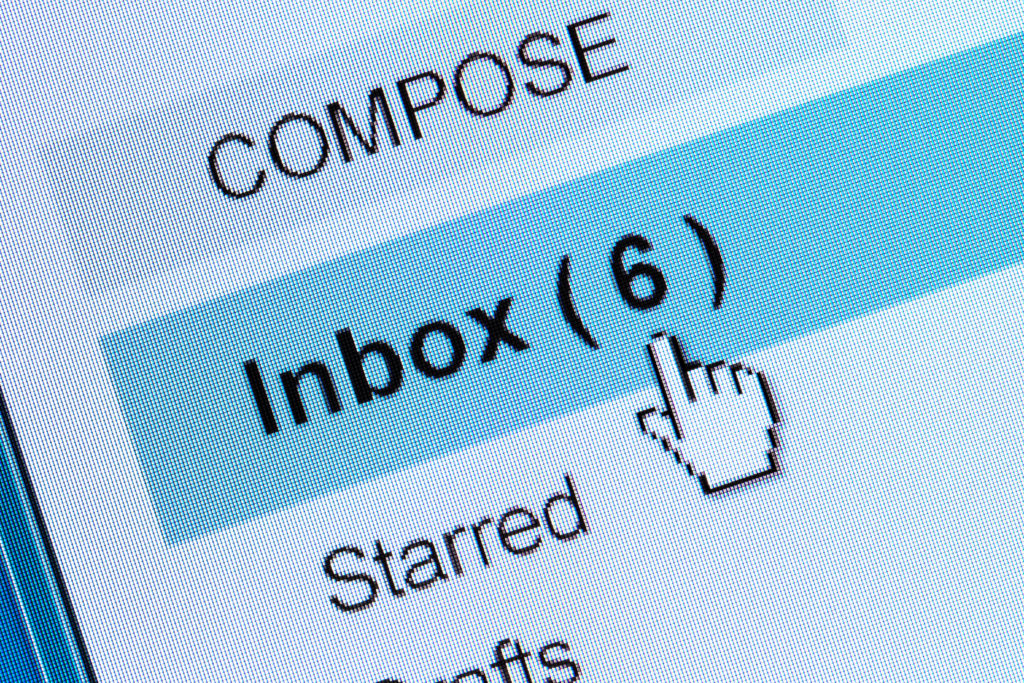
Make Email Work For You: The Secret to Better Business Emails
Email isn’t going anywhere. It continues to be a strong channel for businesses to use to communicate, build relationships, and grow customer loyalty. But if you want to get the most out of email, you must have the right email strategy.
Developing a High-Converting Email Marketing Strategy
The average email open rate across all industries hovers around 19% to 22%. If you want to be at least average—or even better—above average, here are some tips you’ll need to follow:
- Write mobile-friendly copy. Email is one of many marketing channels that are shifting to mobile. Over 80% of shoppers check their emails regularly from their smartphones.
- Write better email subject lines. Use emojis, personalization, numbers, or ask a question to make your subject lines more engaging.
- Don’t overdo it. Nearly 70% of consumers unsubscribe because they’re receiving more emails than they’d like.
- Look at all your email metrics to learn where to improve. Open rates tell only one part of the story. Click-through and conversion rates can also help you identify weak areas in your email messaging.
- Keep your email list current. You should scrub any subscribers listed as hard bounces from your lists to protect your email deliverability and keep your average email open rate as accurate as possible.
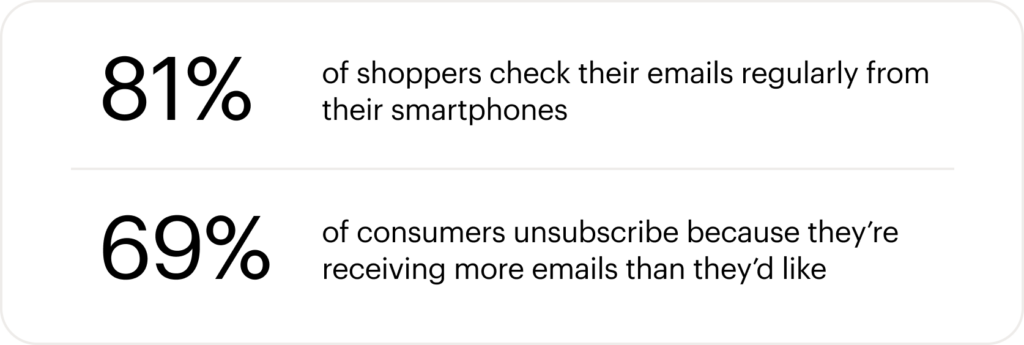
Managing Email Volume and Cadence
Nothing is more anxiety-inducing than an overflowing inbox.
Employees frequently struggle with too many emails, which results in response delays. Email inquiries may also land in the wrong person’s inbox. As a result, for many business owners, emails can often go unchecked for hours.
One of the great features of an email management tool is that it makes it easy to pass conversations between team members. Additionally, team members can see a customer’s previous interactions with your employees so they can pick up in the right place.
Regarding picking the right cadence for your email communications, the most important determining factor in the frequency should be who your target customers are and what their typical purchase cycle is. For instance, if customers usually make repeat purchases every six months, you don’t want to target them right after they’ve made a purchase.
Additionally, look at subscribers’ engagement to help you determine the best cadence. Active subscribers can be emailed more often, while you should reduce the frequency of emails for disengaged subscribers.
You should also adjust your email cadence based on your overall marketing goals. Whether you’re trying to build loyalty, encourage them to schedule an appointment, or drive them to your physical location can all impact how frequently you want to email them. You should also factor in other advertising and communications they may be receiving so that you’re not spamming them.
Finally, you should set clear expectations about when and why you’ll be emailing them from the outset. If you send daily emails, tell them they are signing up for DAILY emails.
Automating Email to Scale Communication
Email is a no-brainer for automation. You can easily create entire email campaigns that are fully automated and still great a great customer experience. From welcome emails to promotional emails, the possibilities for campaigns are limitless.
In addition, you can further streamline email campaigns by using templates. This makes it easy to change key information and images and get your messages out quickly. Email software also makes it easy to personalize emails with names and other information you have in your CRM.
Business Email Best Practices
The best emails are those that are relevant, personalized, and well-timed. To hit it out of the park with your next email campaign, keep these best practices in mind:
- Segment your email list. You can segment by engagement or by other audience demographics such as age, location, gender, etc. This will help you better personalize emails to what is relevant to each segment.
- Be concise. Keep it short, simple, and to the point, if you want to keep your readers’ attention.
- Optimize your send time. This may take some testing but look at your data to determine if there are certain days or times of days that people are more likely to open your emails.
- A/B test. Testing is the only way to know what works and what doesn’t. Test send times, frequency, subject lines, etc.
- Send only when you have something valuable to share. If your emails don’t provide value, your audience will begin to disengage.

Bringing It All Together
You want to be there for the moments that matter most to customers. We hope with this guide you’ll have a better idea of where to pool your resources and how to work smarter and scale faster across communication channels.
Communicating with your customers on their preferred channels is a critical part of the customer experience, but it’s only half the battle. The other half is managing all of these different communication technologies in a cohesive and efficient manner. And the best way to do this is with a single inbox, where all texts, calls, chats, and emails are recorded and accessible to your entire staff.
When all communications are in one place, it gives you the visibility to ensure every customer inquiry or lead is followed up on promptly. It also makes transferring inquiries to the right person easier and less time-consuming, regardless of the channel.
Finally, customers no longer have to repeat themselves because all the information your employees need about previous communications with the customer is at their fingertips.